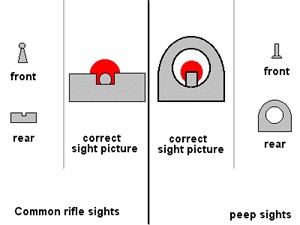Back to training page
Home
Typically there are 2 types of ‘iron’ sights used on military and civilian rifles. The first, and probably most common rifle sight looks like the ones in the left of the picture below. The other type are called peep sights, and are pictured in the right hand part of the illustration. (The red dot is the center of your target.)

No matter which type of sights your rifle has, the same basic rules apply. To be correctly sighted in, the top of the front sight post should be level with the center of the target, and the front sight itself should be centered in the opening of the rear sight. The bullets should hit directly where you are looking.
If the bullet is not hitting where you are aiming, you must move the sights to correct the problem. Moving the front sight up will cause the bullet strike to move down, and vise versa. Moving the rear sight up will cause the bullet strike to move up, and vise versa.
Moving the front sight left will move the bullet strike right, while moving the rear sight left will move the bullet strike left.
In short, the front sights are adjusted opposite of the direction you intend to move the bullets impact, and the rear sights are adjusted in the same direction.
Use this chart to help find and correct errors.
Either of these charts are free to use, as long as you leave the Sportshooter.com logo intact.
Now that you understand how to properly sight in the rifle, we'll move on to 'zeroing' the rifle. Without getting to technical, I'll try to explain the basics of zeroing.
As the bullet travels to the target, it follows a 'ballistic arc'. The picture below demonstrates this, but is grossly exaggerated for clarity.

The blue line represents your line of sight throught the sights and to the target.
The red line represents the ballistic arc of the bullet.
The green line closest to the gun is the starting zero. This will be farther from the gun if you sites are higher off the barrel, or if the bullet has a flat trajectory.
The second green line is where a rifle is 'zeroed'.
You can zero a rifle at any range you wish, but it is best to zero it at a range where the bullet will not rise more than a few inches before it falls to the zero point. For the 223 caliber, which has a very flat trajectory, you should zero at 300 yards. You will need to get the specific information on your caliber rifle to zero properly.
The instruction manual for your gun may have this information. Otherwise use a search engine to search for "ballistics" "trajectory" and the caliber of your weapon. Or you can consult a gun dealer, gunsmith, or local reloading guru.
Why is zeroing important? Without zeroing your rifle, you have no way to determine how to adjust your sights for ranges beyond the far zero line. Many rifles has sights that are ajustable for range, but these sights do you no good if you do not zero the rifle.


